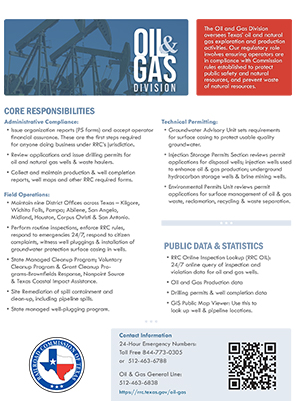
Proration Schedules
Oil & Gas ANNOUNCEMENTS
Notice to Operators
Disposal Well Monitoring and Reporting Requirements in the Permian BasinDecember 19, 2023
Supersedes the February 2023 Notice
The Railroad Commission of Texas (RRC) intends to clarify the Notice issued on February 6, 2023, as follows:
Operators of new and amended disposal well permits in the greater Permian Basin[1] shall assist the RRC in monitoring and responding to injection and reservoir conditions that may be conducive to induced seismicity or resulting in excessive reservoir pressures.
All new or amended saltwater disposal (SWD) permits will have a requirement to collect and report initial and periodic static bottomhole pressure (BHP) measurements. The BHP measurements may be collected by one of the following methods:
- Calculated BHP Method: Operator shall pump twice the tubing-volume of a fluid of a known density. The well will be shut-in for at least 24 hours, after which the shut-in surface pressure will be recorded. The BHP will be calculated by BHP = surface pressure + hydrostatic pressure and corrected to a depth indicated by the operator as the shallowest open vertical depth of the completed disposal interval. If the well fails to maintain a fluid level to surface, a fluid level shall be acquired by using reliable downhole tools and technology. The BHP should then be calculated by the hydrostatic pressure of the liquid column extending from the fluid level depth to a depth indicated by the operator as the shallowest open vertical depth of the completed disposal interval. Using this method, measurements must be obtained and reported quarterly.
- Dip-in BHP Measurement Method: The well will be shut-in for at least 24 hours before pressure measurement is taken. A BHP measuring device will be run in the well. Gradient stops will be made starting at the wellhead. The gradient survey stops intervals shall be no more than 1000’. Gradient stops will be made down to a measured depth within 500’ of top perf. Operator shall report pressure (PSIG), MD, and TVD for all gradient stops, and the final bottomhole pressure corrected to top of completed disposal interval. Using this method, measurements must be obtained and reported quarterly.
- Permanent BHP Probe Method: A surface readout bottomhole pressure probe shall be installed in the well. The permanently installed BHP probe shall be installed prior to first injection and corrected (extrapolated) to the top of completed disposal interval. Using this method, measurements must be obtained daily and reported monthly.
In addition, all new and amended SWD permits will have a permit condition to collect daily injection volume and daily surface injection pressure data, and to report this data monthly. This will include the following daily parameters:
- Maximum surface injection pressure (pounds per square inch)
- Average surface injection pressure (pounds per square inch)
- Injection volume (barrels per day)
- Maximum injection rate (barrels per minute)
Permits issued pursuant to this notice will instruct operators to submit the data via the Bureau of Economic Geology’s (BEG) TexNet Injection Volume Reporting Tool available at https://injection.texnet.beg.utexas.edu/, which is available to industry, academia, the public and RRC staff.
In addition, RRC requests all existing disposal wells in the greater Permian Basin with a permitted maximum daily injection rate of 5,000 barrels or more to collect the daily injection data described above and to report it monthly via the BEG TexNet tool.
Permits issued pursuant to the February 2023 notice may be amended to be in accordance with the terms of this revised notice. To request an in-house amendment from the RRC’s Injection-Storage Permits and Support Unit, please email the current permit to [email protected] and describe the requested changes.
[1] For this notice the greater Permian Basin includes all counties in RRC Oil and Gas Districts 7C, 8, and 8A, and Fisher County in District 7B.
What we do
The Railroad Commission, through its Oil and Gas Division, regulates the exploration, production, and transportation of oil and natural gas in Texas. Its statutory role is to:
- prevent waste of the state's natural resources,
- to protect the correlative rights of different interest owners,
- to prevent pollution, and
- to provide safety in matters such as hydrogen sulfide.
The division accomplishes these goals by permitting and reporting requirements; by field inspections, testing programs and monitoring industry activities in the field; and through programs to remediate abandoned wells and sites through the use of fees and taxes paid by industry.
The Oil and Gas Division is headquartered in Austin, Texas with nine district offices spread over the state.
Drilling Permit Processing Time as of May 17, 2021
Expedited Permits: approximately 2Business days
Standard Permits: approximately 4
Business days








